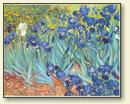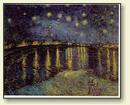| Relevant paintings: 
"Irises," Vincent van Gogh
[Enlarge]

"Starry Night over the Rhone," Vincent van Gogh
[Enlarge]
|
Letter T 16
Paris, 5 September 1889
My dear Vincent,
You gave me great pleasure by writing me a letter; when one
knows nothing one is inclined to think things are worse than
they really are. It is bad enough in itself that you have had a
crisis, but fortunately I see from your letter that at present
you are feeling better. The view from your window - which you
give a sketch of - ought to be very fine; in Paris one is
sometimes dying for a look at the real countryside - at least
you have a fragment of it at your disposal. In the environs of
Paris you never see any peasants, and in truth I no longer know
the harvest times for wheat and potatoes. It is a fact that in
town you meet people who are certainly interesting too, but at
times you have had enough of it, and so, as long as you cannot
go there, a picture of the true countryside does you good, and
certainly at such moments of surfeit a Bodmer1 will give you as much pleasure,
or rather more than some picture done with a scientifically clever technique,
but without that true and wholesome something which is to be
found in a slice of brown bread. Rousseau too has something of
this knowledge. At the exhibition there are pictures of his
with bits of forest, in which you can recognize all the species
of trees with an undergrowth of true heath and true toadstools
beneath. Surely if such fellows are no artists—and one
would have to be damned exacting not to take them as
such—in any case they are men, and one should wish
the world to be full of them.
There you have old Father Pissarro, 2 who,
notwithstanding everything, has done very fine things recently,
and in them you also find those qualities of rusticity which
show immediately that man is more at ease in wooden shoes than
in patent-leather boots. A short time ago he lost his mother,
who was very old, and yet it was a hard blow for him; he also
had an operation performed on one of his eyes, but I do not
think it was improved by it. He is continually wearing some
kind of muzzle, which bothers him a good deal . . . He has
great difficulty selling his stuff, and he has been through
hard times, but he is always full of courage. One of his sons
is in London, and it appears that they have schools there where
one is taught decorative art, and where the pupils are
absolutely free to treat the subject as they understand it. The
first thing they gave him to do was a frieze composed of
brambles. It would be a good thing if they did the same here,
for by letting the fellows follow their own inclinations, they
would find ornaments drawn from the source of nature, and the
result might be a great change in the art of interior
decoration, etc. It is a pity that the impressionists are
unknown in England; there must be people over there who would
like them.
This week Tersteeg sent me eight watercolours by J.H.
Weissenbruch, who in parentheses is not dead; they are very,
very fine. Although he does not concern himself with details of
the vegetation, he knows the character of the Dutch countryside
as Daumier knows his barristers - the misshapen trees, the
muddy paths across the meadows, and how his skies are like
those you see in Holland! I am very glad that Tersteeg has had
the courage to buy them from him; he is always the same: he
invariably begins by saying No, and then after some time he
goes back on it, and often changes his mind. Here where they
have understood Jongkind, 3 they will also be able
to understand this one. In any case one might try it.
Gauguin has sent me some new canvases. He tells me that he
hesitated to send them, because what he is striving for is not
in them as he should have wished. He says he did find it in
other canvases, which are not dry yet. However, in my opinion
it is a certain fact that this consignment is not as good as
the one he sent last year; there is one canvas, however,
which is a really fine Gauguin once again. He calls it
“La Belle Angèle.” It is a portrait put
down on the canvas like the big heads in the Japanese
crêpons; there is the bust-portrait with its
outlines and then the background. It is a Breton woman, seated,
the hands folded, black dress, lilac apron, and a white ruff;
the outlines are grey and the background of a beautiful blue
lilac with pink and red flowers. The expression of the head and
the attitude are very well found. The woman is somewhat like a
young cow, but there is something so fresh in it, and then
again something so countrified, that it is very pleasant to
see.
Now I still have to tell you that the exhibition of the
Independents is open, and that your two pictures are there, the
“Irises” and “The Starlit
Night.” The latter is hung badly, for
one cannot put oneself at a sufficient distance, as the room is
very narrow, but the other one makes an extremely good showing.
They have put it on the narrow wall of the room, and it strikes
the eye from afar. It is a beautiful study full of air and
life. There are some Lautrecs, which are very powerful in
effect, among other things a Ball at the Moulin de la Galette,
which is very good. The painters could only send in two
pictures each, as the exhibition is held in a much smaller
place than the one it was held in till now.
Seurat has sea beaches, Signac two landscapes. There is also
a picture by Hayet, the friend of Lucien Pissarro's, the Place
de la Concorde in the evening with carriages, the gas jets,
etc. It is something like that picture of the Tumblers
[Saltimbanques] by Seurat, but it is more harmonious.
Jo too is quite well; one begins to see that she is pregnant,
but it does not hinder her yet. One of the sisters is staying
with us at the moment. Mother has had a letter from Cor; he is
far away already, and was in good health.
Do write me a few words if you feel like it, and once again
many thanks for your letter.
Be of good heart; and a cordial handshake, also from Jo.
Yours, Theo
-
See Vincent's letter 605.
-
See Letter T 50.
-
Johan Barthold Jongkind (1819-1891), one of the great
precursors of impressionism.
At this time, Vincent was 36 year oldSource:
Theo van Gogh. Letter to Vincent van Gogh. Written 5 September 1889 in Saint-Rémy. Translated by Mrs. Johanna van Gogh-Bonger, edited by Robert Harrison, number T16.
URL: https://www.webexhibits.org/vangogh/letter/20/T16.htm.
This letter may be freely used, in accordance with the terms of this site.
|